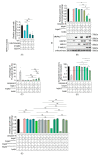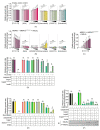Reconstitution of Human Necrosome Interactions in Saccharomyces cerevisiae
- PMID: 33503908
- PMCID: PMC7911209
- DOI: 10.3390/biom11020153
Reconstitution of Human Necrosome Interactions in Saccharomyces cerevisiae
Abstract
The necrosome is a large-molecular-weight complex in which the terminal effector of the necroptotic pathway, Mixed Lineage Kinase Domain-Like protein (MLKL), is activated to induce necroptotic cell death. The precise mechanism of MLKL activation by the upstream kinase, Receptor Interacting Serine/Threonine Protein Kinase 3 (RIPK3) and the role of Receptor Interacting Serine/Threonine Protein Kinase 1 (RIPK1) in mediating MLKL activation remain incompletely understood. Here, we reconstituted human necrosome interactions in yeast by inducible expression of these necrosome effectors. Functional interactions were reflected by the detection of phosphorylated MLKL, plasma membrane permeabilization, and reduced proliferative potential. Following overexpression of human necrosome effectors in yeast, MLKL aggregated in the periphery of the cell, permeabilized the plasma membrane and compromised clonogenic potential. RIPK1 had little impact on RIPK3/MLKL-mediated yeast lethality; however, it exacerbated the toxicity provoked by co-expression of MLKL with a RIPK3 variant bearing a mutated RHIM-domain. Small molecule necroptotic inhibitors necrostatin-1 and TC13172, and viral inhibitors M45 (residues 1-90) and BAV_Rmil, abated the yeast toxicity triggered by the reconstituted necrosome. This yeast model provides a convenient tool to study necrosome protein interactions and to screen for and characterize potential necroptotic inhibitors.
Keywords: RHIM; RIP; S. cerevisiae; kinase; necroptosis; necroptotic inhibitor; overexpression; phosphorylation; subcellular localization; yeast.
Conflict of interest statement
No potential conflict of interest were reported by the authors.
Figures





Similar articles
-
Herpes simplex virus 1 ICP6 impedes TNF receptor 1-induced necrosome assembly during compartmentalization to detergent-resistant membrane vesicles.J Biol Chem. 2019 Jan 18;294(3):991-1004. doi: 10.1074/jbc.RA118.004651. Epub 2018 Nov 30. J Biol Chem. 2019. PMID: 30504227 Free PMC article.
-
CAMK2/CaMKII activates MLKL in short-term starvation to facilitate autophagic flux.Autophagy. 2022 Apr;18(4):726-744. doi: 10.1080/15548627.2021.1954348. Epub 2021 Jul 20. Autophagy. 2022. PMID: 34282994 Free PMC article.
-
Identification of MLKL membrane translocation as a checkpoint in necroptotic cell death using Monobodies.Proc Natl Acad Sci U S A. 2020 Apr 14;117(15):8468-8475. doi: 10.1073/pnas.1919960117. Epub 2020 Mar 31. Proc Natl Acad Sci U S A. 2020. PMID: 32234780 Free PMC article.
-
Molecular Insights into the Mechanism of Necroptosis: The Necrosome As a Potential Therapeutic Target.Cells. 2019 Nov 21;8(12):1486. doi: 10.3390/cells8121486. Cells. 2019. PMID: 31766571 Free PMC article. Review.
-
Viral-induced neuronal necroptosis: Detrimental to brain function and regulation by necroptosis inhibitors.Biochem Pharmacol. 2023 Jul;213:115591. doi: 10.1016/j.bcp.2023.115591. Epub 2023 May 16. Biochem Pharmacol. 2023. PMID: 37196683 Review.
Cited by
-
Human gasdermin D and MLKL disrupt mitochondria, endocytic traffic and TORC1 signalling in budding yeast.Open Biol. 2023 May;13(5):220366. doi: 10.1098/rsob.220366. Epub 2023 May 24. Open Biol. 2023. PMID: 37220793 Free PMC article.
-
Reconstitution of human pyroptotic cell death in Saccharomyces cerevisiae.Sci Rep. 2023 Feb 22;13(1):3095. doi: 10.1038/s41598-023-29464-5. Sci Rep. 2023. PMID: 36813876 Free PMC article.
-
Necroptosis in vascular cognitive impairment: mechanisms and therapeutic potential.Front Aging Neurosci. 2025 Jun 25;17:1599773. doi: 10.3389/fnagi.2025.1599773. eCollection 2025. Front Aging Neurosci. 2025. PMID: 40636901 Free PMC article. Review.
-
The Many Faces of MLKL, the Executor of Necroptosis.Int J Mol Sci. 2023 Jun 14;24(12):10108. doi: 10.3390/ijms241210108. Int J Mol Sci. 2023. PMID: 37373257 Free PMC article. Review.
-
Modeling Necroptotic and Pyroptotic Signaling in Saccharomyces cerevisiae.Biomolecules. 2025 Apr 4;15(4):530. doi: 10.3390/biom15040530. Biomolecules. 2025. PMID: 40305268 Free PMC article. Review.
References
MeSH terms
Substances
LinkOut - more resources
Full Text Sources
Other Literature Sources
Molecular Biology Databases
Miscellaneous

